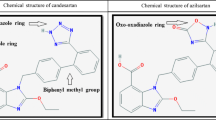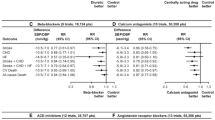Abstract
Angiotensin receptor antagonists (angiotensin receptor blockers; ARBs) are an effective initial antihypertensive monotherapy in many patients. However, when initial ARB monotherapy fails to achieve the recommended BP goal, there is some controversy as to whether dose uptitration or the addition of a diuretic is more appropriate. This article addresses this issue by reviewing the dose-response characteristics of olmesartan medoxomil and other ARBs, as well as the relationship between ARB uptitration and BP goal attainment.
Two types of trial designs are used to assess dose response: dose-ranging studies (usually a parallel design using different doses across different patient groups), which are used to establish the optimal dose for US FDA registration purposes, and dose-titration studies (increased dosing within the same patients and treating to goal BP). Since dose titration is within the same patient, it may be considered more appropriate for demonstrating dose-response characteristics and demonstration of BP goal attainment. While results from dose-ranging studies suggest that the dose-response curve for some ARBs may be flat, dose-titration studies indicate that significant improvements in BP control and BP goal attainment can be achieved with ARB uptitration.
In an integrated analysis of seven US and European randomized, placebo-controlled, dose-ranging trials involving 3055 patients with stage 2 hypertension treated with olmesartan medoxomil 2.5–80 mg/day or placebo for 8 weeks, all olmesartan medoxomil doses were significantly more effective than placebo in lowering the mean DBP and mean SBP (p ↓0.001); notably, optimal BP-lowering efficacy was observed at higher dosages. In fact, the 20 mg/day (recommended starting dose) and 40 mg/day (maximum approved dose) dosages were significantly (p ↓0.001) more effective in lowering mean BP than the 5 mg/day dosage (optional starting dose in volume-depleted patients), and the 40 mg/day dosage was significantly (p <0.01) more effective than the 20 mg/day dosage. The BP decreases observed with the uptitration of olmesartan medoxomil from 20 to 40 mg/day doses resulted in substantial additional mean BP reductions from baseline. Such BP reductions have been shown to translate into a clinically relevant increase in the number of patients who achieve BP goal.
In conventional clinical studies, the shallow dose-response findings often attributed to ARBs may be an artifact resulting from the inclusion of both treatment responders and nonresponders within each dose group. However, this may not accurately reflect the results that are actually obtained in clinical practice. The efficacy of certain ARBs, such as olmesartan medoxomil, is dose-dependent, with greater reductions being attained at higher doses; higher BP goal attainment rates are achieved with the higher doses. Thus, ARB monotherapy, with appropriate uptitration as needed, is an excellent initial treatment option for patients with hypertension.




Similar content being viewed by others
References
Fields LE, Burt VL, Cutler JA, et al. The burden of adult hypertension in the United States 1999 to 2000: a rising tide. Hypertension 2004; 44: 398–404.
Benetos A, Thomas F, Bean KE, et al. Why cardiovascular mortality is higher in treated hypertensives versus subjects of the same age, in the general population. J Hypertens 2003; 21: 1635–40.
Chobanian AV, Bakris GL, Black HR, et al. The Seventh Report of the Joint National Committee on Prevention, Detection, Evaluation, and Treatment of High Blood Pressure: the JNC 7 report. JAMA 2003; 289: 2560–72.
European Society of Hypertension-European Society of Cardiology Guidelines Committee. 2003 European Society of Hypertension-European Society of Cardiology guidelines for the management of arterial hypertension. J Hypertens 2003; 21: 1011–53.
Singer GM, Izhar M, Black HR. Goal-oriented hypertension management: translating clinical trials to practice. Hypertension 2002; 40: 464–9.
Giles TD, Oparil S, Silfani TN, et al. Comparison of increasing doses of olmesartan medoxomil, losartan potassium, and valsartan in patients with essential hypertension. J Clin Hypertens (Greenwich) 2007; 9: 187–95.
Oparil S, Silfani TN, Walker JF. Role of angiotensin receptor blockers as monotherapy in reaching blood pressure goals. Am J Hypertens 2005; 18: 287–94.
Smith DH, Dubiel R, Jones M. Use of 24-hour ambulatory blood pressure monitoring to assess antihypertensive efficacy: a comparison of olmesartan medoxomil, losartan potassium, valsartan, and irbesartan. Am J Cardiovasc Drugs 2005; 5: 41–50.
Benz JR, Black HR, Graff A, et al. Valsartan and hydrochlorothiazide in patients with essential hypertension. A multiple dose, double-blind, placebo controlled trial comparing combination therapy with monotherapy. J Hum Hypertens 1998; 12: 861–6.
Chrysant SG, Weber MA, Wang AC, et al. Evaluation of antihypertensive therapy with the combination of olmesartan medoxomil and hydrochlorothiazide. Am J Hypertens 2004; 17: 252–9.
Kochar M, Guthrie R, Triscari J, et al. Matrix study of irbesartan with hydrochlorothiazide in mild-to-moderate hypertension. Am J Hypertens 1999; 12: 797–805.
Manolis AJ, Grossman E, Jelakovic B, et al. Effects of losartan and candesartan monotherapy and losartan/hydrochlorothiazide combination therapy in patients with mild to moderate hypertension. Losartan Trial Investigators. Clin Ther 2000; 22: 1186–203.
Conlin PR, Spence JD, Williams B, et al. Angiotensin II antagonists for hypertension: are there differences in efficacy? Am J Hypertens 2000; 13: 418–26.
Giles TD, Bakris GL, Smith DH, et al. Defining the antihypertensive properties of the angiotensin receptor blocker telmisartan by a practice-based clinical trial. Am J Hypertens 2003; 16: 460–6.
Meredith PA. Is postural hypotension a real problem with antihypertensive medication? Cardiology 2001; 96 Suppl. 1: 19–24.
Puchler K, Laeis P, Stumpe KO. Blood pressure response, but not adverse event incidence, correlates with dose of angiotensin II antagonist. J Hypertens Suppl 2001; 19: S41–8.
Elmfeldt D, George M, Hubner R, et al. Candesartan cilexetil, a new generation angiotensin II antagonist, provides dose dependent antihypertensive effect. J Hum Hypertens 1997; 11 Suppl. 2: S49–53.
Reif M, White WB, Fagan TC, et al. Effects of candesartan cilexetil in patients with systemic hypertension. Candesartan Cilexetil Study Investigators. Am J Cardiol 1998; 82: 961–5.
Kassler-Taub K, Littlejohn T, Elliott W, et al. Comparative efficacy of two angiotensin II receptor antagonists, irbesartan and losartan in mild-to-moderate hypertension. Irbesartan/Losartan Study Investigators. Am J Hypertens 1998; 11: 445–53.
Gradman AH, Arcuri KE, Goldberg AI, et al. A randomized, placebo-controlled, double-blind, parallel study of various doses of losartan potassium compared with enalapril maleate in patients with essential hypertension. Hypertension 1995; 25: 1345–50.
Pool J, Oparil S, Hedner T, et al. Dose-responsive antihypertensive efficacy of valsartan, a new angiotensin II-receptor blocker. Clin Ther 1998; 20: 1106–14.
Neutel JM, Smith DHG. Dose response and antihypertensive efficacy of the AT1 receptor antagonist telmisartan in patients with mild to moderate hypertension. Adv Ther 1998; 15: 206–17.
COZAAR (losartan potassium) [prescribing information]. Whitehouse Station (NJ): Merck & Co., Inc., 2005.
Neutel JM, Smith DH, Weber MA, et al. Use of an olmesartan medoxomil-based treatment algorithm for hypertension control. J Clin Hypertens (Greenwich) 2004; 6: 168–74.
Neutel JM, Smith DH, Silfani TN, et al. Effects of a structured treatment algorithm on blood pressure goal rates in both stage 1 and stage 2 hypertension. J Hum Hypertens 2006; 20: 255–62.
Written communication, Study Report 866–419. Parsippany (NJ): Daiichi Sankyo, Inc., 2007. (Data on file).
Izzo J, Neutel JM, Dubiel R, et al. Efficacy and safety of treating stage 2 systolic hypertension with olmesartan and olmesartan/HCTZ: results of an open-label titration study. J Clin Hypertens 2007; 9: 36–44.
Izzo J, Neutel J, Dubiel R. Efficacy of olmesartan medoxomil and hydrochlorothiazide in achieving blood pressure control and normalization in stage 2 systolic hypertension [abstract]. Am J Hypertens 2005; 18: 64A.
Guthrie R, Saini R, Herman T, et al. Efficacy and tolerability of irbesartan, an angiotensin II receptor antagonist, in primary hypertension: a double-blind, placebo-controlled, dose-titration study. Clin Drug Invest 1998; 15: 217–27.
Bell TP, DeQuattro V, Lasseter KC, et al. Effective dose range of candesartan cilexetil for systemic hypertension. Candesartan Cilexetil Study Investigators. Am J Cardiol 1999; 83: 272–5, A6.
Giles T, Oparil S, Silfani T, et al. Comparison of ascending doses of olmesartan medoxomil, losartan potassium and valsartan in patients with essential hypertension [abstract]. Am J Hypertens 2005; 18: 59A–60A.
Hansson L, Zanchetti A, Carruthers SG, et al. Effects of intensive blood-pressure lowering and low-dose aspirin in patients with hypertension: principal results of the Hypertension Optimal Treatment (HOT) randomised trial. HOT Study Group. Lancet 1998; 351: 1755–62.
Mazzolai L, Burnier M. Comparative safety and tolerability of angiotensin II receptor antagonists. Drug Saf 1999; 21: 23–33.
Pouleur HG. Clinical overview of irbesartan: a new angiotensin II receptor antagonist. Am J Hypertens 1997; 10: 318S–24S.
Markham A, Goa KL. Valsartan. A review of its pharmacology and therapeutic use in essential hypertension. Drugs 1997; 54: 299–311.
Meredith PA. Optimal dosing characteristics of the angiotensin II receptor antagonist telmisartan. Am J Cardiol 1999; 84: 7K–12K.
Acknowledgments
The preparation of this manuscript was supported by Daiichi Sankyo, Inc. Dr Smith is in the Speakers Bureau for Novartis, Bristol Myers Squibb, Sanofi-Aventis, Biovail, Pfizer, Reliant, and Boehringer Ingelheim. We thank Alan J. Klopp, PhD (Wolters Kluwer Health Medical Comunications) for providing editorial assistance in the preparation of this manuscript.
Author information
Authors and Affiliations
Corresponding author
Rights and permissions
About this article
Cite this article
Smith, D.H.G. Dose-Response Characteristics of Olmesartan Medoxomil and Other Angiotensin Receptor Antagonists. Am J Cardiovasc Drugs 7, 347–356 (2007). https://doi.org/10.2165/00129784-200707050-00004
Published:
Issue Date:
DOI: https://doi.org/10.2165/00129784-200707050-00004




